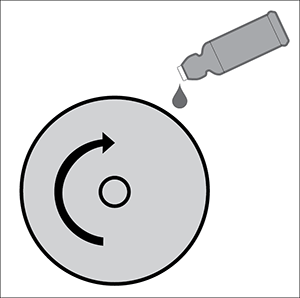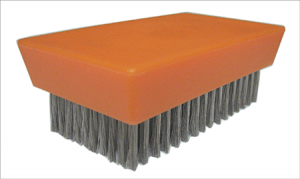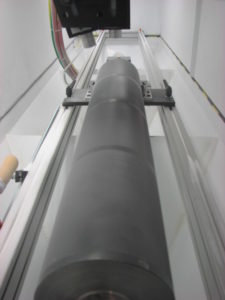 You spend a lot of time selecting the correct anilox roll for a job. Careful consideration goes into line screen, cell geometry and cell volume in order to guarantee that a precise amount of ink or coating is delivered to the substrate. Aniox roll cleaning is essential to maintain this precision. If you neglect to clean your rolls on a regular basis, you will not get the most out of your anilox investment. Plugged cells will affect print quality and cause you frustration, waste and downtime. An anilox roll cleaning program consisting of daily, weekly and deep cleaning will preserve the integrity of the anilox engraving and ensure quality, press efficiency and longer anilox life.
You spend a lot of time selecting the correct anilox roll for a job. Careful consideration goes into line screen, cell geometry and cell volume in order to guarantee that a precise amount of ink or coating is delivered to the substrate. Aniox roll cleaning is essential to maintain this precision. If you neglect to clean your rolls on a regular basis, you will not get the most out of your anilox investment. Plugged cells will affect print quality and cause you frustration, waste and downtime. An anilox roll cleaning program consisting of daily, weekly and deep cleaning will preserve the integrity of the anilox engraving and ensure quality, press efficiency and longer anilox life.
When a newly engraved anilox roll arrives from the manufacturer, volume is even across and around the surface of the roll. As the roll is used, however, a residual amount of ink or coating material is left behind in the cells after the transfer has taken place. The residue dries and creates build-up in the cells. Over time, these deposits decrease the capacity of the cells and reduce their ability to carry and release the volume of liquid for which they were designed. This residue also raises the surface tension, or dyne level, of the roll and increases the tendency of the coating to “cling” to the surface. When this occurs, the roll will not release the proper volume or ink or coating to the plate.
Benefits of regular anilox roll cleaning:
- The repeated transfer of a precise volume of ink or coating
- Consistent coverage
- Reduced labor and less downtime
- Fewer job rejections and waste
- Longer anilox life and lower re-working costs
Flexo Concepts recommends a 3-step anilox roll cleaning program:
1. Daily wiping to prevent ink or coating build-up
Applying a liquid cleaning agent by hand and wiping down the roll with a clean, lint-free cloth on a daily basis is the simplest and most effective way to keep ink and coating from drying and building up in the cells. As a basic rule of thumb, the best time to clean a roll is as soon as it is removed from the press. The longer inks, resins, adhesives, etc. have been allowed to sit in the engraving, the harder these materials are to remove. To maximize cleaning performance, choose a cleaner specifically formulated to remove water-based, UV or solvent-based chemistries based on your application.
2. Weekly scrubbing with a paste-like cleaner and an anilox cleaning brush
 Manually scrubbing the roll once or twice a week with a brush and a paste or cream chemical cleaner will mechanically loosen and remove any ink or coating residue that remain in cells despite daily cleaning. The cleaner is applied to the roll, vigorously scrubbed in a circular motion with an anilox cleaning brush and flushed with water while the roll remains in the press. It is important to remember that stainless steel brushes are suitable only for ceramic anilox surfaces and brass bristles should be used for chrome surfaces to prevent damage to the engraving.
Manually scrubbing the roll once or twice a week with a brush and a paste or cream chemical cleaner will mechanically loosen and remove any ink or coating residue that remain in cells despite daily cleaning. The cleaner is applied to the roll, vigorously scrubbed in a circular motion with an anilox cleaning brush and flushed with water while the roll remains in the press. It is important to remember that stainless steel brushes are suitable only for ceramic anilox surfaces and brass bristles should be used for chrome surfaces to prevent damage to the engraving.
3. Monthly deep cleaning to remove tough ink or coating deposits
Over time a residual amount of ink or coating material is left behind in the cells and the roll requires a deep cleaning to remove these tough deposits. The most common methods of deep cleaning are chemical wash and ultrasonic. With these methods, the roll is removed from the press and placed into a chemical bath where it soaks in a powerful cleaning solution before being subjected to a high pressure rinse or ultrasonic vibrations to loosen and dissolve the deposits. These methods vary in cleaning effectiveness, risk of damage to the roll, and water and chemical consumption.

There are also particle-blasting methods of mechanically removing the dried cell contents. These methods are especially effective for removing chemistries that may be resistant to chemical cleaners. Soda blasting technology uses small granules of sodium carbonate to go in and “pick out” the ink or coating. The roll is then rinsed with water and wiped to remove any remaining soda residue. A more eco-friendly method to deep cleaning anilox rolls that uses no water or chemicals is the MicroClean™ System: an off-press, completely dry media cleaning machine that uses recyclable plastic media pellets. The system gently but thoroughly removes all types of dried inks and coatings, virtually restoring cell volume to full capacity with each cleaning.
Laser cleaning is another anilox deep-cleaning method that’s growing in popularity and effective at removing chemical-resistant ink and coating deposits. The technology uses a pulsed laser beam to heat and evaporate the tough residue in the anilox cells. This method requires no consumable and produces no waste stream, although the capital investment is high.
Like on other parts of the press, a maintenance program for anilox rolls keeps the ink delivery system running at its peak. Regular anilox roll cleaning will prevent anilox cells from plugging with residue and stop build-up before it dries. Maintaining anilox rolls through a regular cleaning program can pay off tremendously in terms of maximizing print quality, press efficiency and cost control. Click here for more information on our anilox roll cleaning brushes
